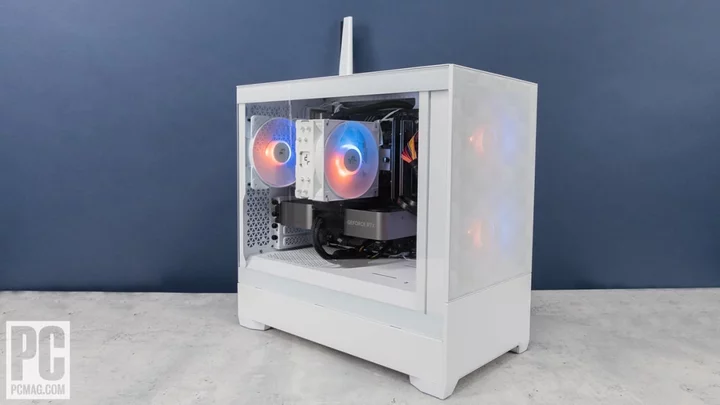Building your own gaming PC—whether it's your first or your tenth—is an exciting venture. For some, the joys of creating your own computer and then testing its limits is its own reward. For others, the fun lies in getting the look of the system just right for bragging rights, followed by the thrill of the first power-on. First, before you even pick up a screwdriver, you need to do a fair bit of research and think about exactly what you want in a gaming PC.
That's especially true if you want to build a compact gaming PC. You need to pay extra attention not only to what components fit your budget, but what will fit together, period. Sound daunting? Don't fret: We’ve used our testing and build expertise to handpick parts for a powerful little sweet-spot gaming PC that anyone can enjoy for right around $1,300 (give or take a few bucks, due to day-to-day price fluctuations). Let’s get into it!
The Key Components
We've built out our sample compact gaming desktop in the comprehensive video up top. If you want the blow-by-blow on exactly how to put all the pieces together, down to the last cable and screw, plus a discussion of the whys and hows of each part, check it out. PCMag's Executive Editor and Lab Director, John Burek, and Senior Hardware Analyst Matthew Buzzi put it all together right there, and we've included live links to shop for each part as we go, in case you want to replicate our efforts.
(Credit: Joseph Maldonado)Deciding exactly how much to spend on a gaming PC, and which parts to buy, is arguably the single greatest challenge; we can make a video teaching you how to put the parts together, but we can't manage your budget. The desktop we built for this project should capably deliver an enjoyable gaming experience with any modern game at 1080p or 1440p resolution for around $1,300. And if you can't spend quite that much, it's easy to dial down a few parts to make the build more affordable. In particular, opting for a more affordable graphics card can save you hundreds; while performance will drop, you can still put together a highly capable 1080p gaming rig for around $1,000.
Now, that's not to say that this is the end-all, be-all, beat-them-all gaming desktop. Some top-end graphics cards these days cost as much as this whole PC! You won't be running every game with maxed-out settings at 100 frames per second (fps) at 4K resolution. This build's Nvidia GeForce RTX 4070 card simply isn't capable of that. You'd want something more like the GeForce RTX 4090 for that kind of Mount Everest performance, and at $1,599, that card exceeds our entire ingredient list here.
What the RTX 4070 will let you do, however, is run most every modern game with reasonably high graphics settings and frame rates. When we reviewed Nvidia's GeForce RTX 4070 Founders Edition graphics card, it ran every game we threw at it with maxed-out graphics settings at 1080p, reaching 118fps or better in every title. Stepping up to 2,560 by 1,440 (1440p) resolution with most of our test titles saw them significantly exceed 60fps; none dropped below that framerate, considered the performance floor by most modern gamers. Even at 4K, every game we tested remained playable if not quite able to hit that 60fps target.
The GeForce RTX 4070's excellent, well-rounded performance, paired with its price of around $599 (far more attainable than cards like Nvidia's GeForce RTX 4080 or AMD's Radeon RX 7900 XTX) led us to choose it for this build. Performance-wise, all but the most demanding gamers should be satisfied with the 4070.
We understand if some first-time builders are hesitant to drop $599 on a single component. For them, we'd suggest Nvidia's GeForce RTX 4060 or AMD's Radeon RX 7600 instead. Neither is a match for the RTX 4070, but starting at $299 and $269 respectively, they're a lot budget-friendlier. Both can drive games at 1080p with maxed graphics settings, and they can run some older games at higher resolutions as well.
(Credit: Molly Flores)We selected the rest of our parts primarily from the perspective of finding the right hardware to support a GeForce RTX 4070 build. We'll go over most of the components in greater detail below, and we'd recommend sticking fairly close to the parts we selected. The PC case or chassis can, of course, be changed out without too much consequence if you find another you like better (so long as the parts fit!). We chose ours for the other intangible beyond performance: bling! The Fractal Design Pop Mini Air delivers plenty of clean styling and cool RGB lighting for the money.
Whether the cool factor matters is naturally up to you. But if you opt to go with less RAM, a different type of storage, or a lower-end processor, you could end up with lesser overall performance.
(Credit: Joseph Maldonado)Reducing the RAM or dialing back the storage solution to a SATA solid-state drive or a hard drive instead of our PCI Express SSD will hurt load times in some scenarios. The Intel Core i5 CPU should be perfectly adequate for gaming with a GeForce RTX 4070, but is realistically the slowest option we feel comfortable recommending for this build. A Core i3 or AMD Ryzen 3 just won't quite cut it. Contrarily, there's nothing inherently wrong with buying faster parts, but we likewise don't expect you'd see really big performance gains by opting for other components close in price; you'd need to really boost your budget. Balance is always key when building a gaming PC, and while this system isn't Zen, it's pretty on-point.
Now, let's run through all the bits we chose, and why.
The Graphics Card
Nvidia GeForce RTX 4070
(Credit: Molly Flores)The graphics card is the single most important component of a gaming PC, which is why you should pick it first. GPU prices have been rising in recent years, with even "budget" options now costing hundreds of dollars. There are a few workable cards available for under $200, but unless you're on the tightest of budgets, you should be prepared to spend more than that for solid 1080p gameplay. To be honest, it's not uncommon nowadays for serious gamers to spend almost as much on a graphics card as on the rest of the system combined.
For this particular build, as we said, our choice was Nvidia's GeForce RTX 4070. Part of the company's new RTX 40 series product line, it's one of the few current options unlikely to be replaced or superseded in the near future. It also supports Nvidia's DLSS 3 technology, which can significantly boost performance in games that support it under the right conditions.
Nvidia built the RTX 4070 with 5,888 CUDA cores, 184 texture mapping units (TMUs), 64 raster operation processors (ROPs), and 46 ray-tracing cores (RT cores). This mass of resources comes clocked at 1,920MHz with a boost clock of 2,475MHz. The card is also equipped with 12GB of GDDR6X memory that connects to the GPU over a 192-bit memory interface. In spite of the high resource count and higher clock speeds, the RTX 4070's power consumption isn't particularly high for a graphics card of this caliber, as it's rated at just 200 watts.
The RTX 4070 offers excellent performance at its current price point, with sufficient power for enjoyable gaming at both 4K and 1440p resolutions. Our test results showed the RTX 4070 was able to run most of our test games at 4K with maxed-out settings at over 60fps, today's primary performance target. It was able to run at significantly higher framerates with the resolution dialed down to 1080p or 1440p, making it a solid option for competitive esports titles, too. Nvidia's GeForce RTX 3080 and AMD's Radeon RX 6950 XT give the RTX 4070 a run for its money, but both are previous-generation cards that lack support for DLSS 3 and have lesser ray-tracing performance.
One critically important note on buying an RTX 4070 is to ensure you don't overpay. The GPU has a "starting" MSRP of $599, and you can find plenty of models available for that price. Going slightly higher than that isn't the worst idea if you see a card with an aesthetic design you prefer or a better thermal solution. But do not pay vastly more than the $599 asking price.
Asus Dual GeForce RTX 4070 White OC Edition (12GB)
Gigabyte GeForce RTX 4070 Aero OC 12G
The PC Case
Fractal Design Pop Mini Air RGB
(Credit: Molly Flores)The chassis is a sensible next step after picking your graphics card; it will help you to hammer down what other components you will pick. The case limits the size of the components you can place inside, so making it one of the first items you select will help you guarantee compatibility. (Of course, you need to be sure the graphics card you choose will fit; GPU maximum length is a measurement you should see on every PC case spec sheet.)
(Credit: Molly Flores) (Credit: Molly Flores)A case is also a decorative item in many ways, and you'll want to make sure you get one that you like. We went with the Fractal Design Pop Mini Air, a MicroATX chassis. It's far more compact than a large ATX tower case, helping to save space in your home. At the same time, it's not as small as a Mini-ITX case; those small-form-factor boxes can be difficult for inexperienced builders due to their tight interior constraints.
(Credit: Molly Flores) (Credit: Molly Flores)One of the big reasons we went with it? The Fractal Design Pop Mini Air ships with three preinstalled RGB fans that connect to an integrated hardware RGB controller. This gives the case plenty of airflow to keep the internal parts from overheating and also adds a lot of extra flair without the complexity that a third-party RGB controller or motherboard-based software control can add. The case also comes with a front-facing 5.25-inch drive bay for adding a DVD drive (hidden behind a magnetic front panel), rare on modern cases but useful for some disc diehards.
Fractal Design Pop Air Mini RGB (White)
The CPU
Intel Core i5-13400F
(Credit: Molly Flores)The processor for this build is Intel's Core i5-13400F, a little under or over $200 at this writing. We opted for this CPU for a number of reasons, but pricing was a key factor. We haven't tested this exact chip before, but we were able to roughly gauge its performance relative to the Core i5-13600K and Core i5-12600K, both of which we have reviewed.
The Core i5-13400F shares the same microarchitecture as the Core i5-13600K, but has four fewer Efficient cores (E-cores). This leaves it with a total of six Performance cores (P-cores) with a max turbo clock of 4.6GHz and four E-cores that top out at 3.3GHz. The chipmaker's Core i5-12600K has the same core count but is clocked a bit higher, with its P-cores hitting 4.9GHz and its E-cores maxing out at 3.6GHz.
Thanks to architectural improvements, the Core i5-13400F should be able to eke out slightly more performance per clock than the Core i5-12600K. This should help somewhat to make up for its slightly lower clocks. Though it's hard to say exactly how this will affect performance, it's reasonable to say that the two should deliver rather similar results. We'll be formally testing the 13400F soon.
(Credit: Molly Flores)From our reviews of the Core i5-12600K and Core i5-13600K, we're confident that the Core i5-13400F will be able to cope with the GeForce RTX 4070 without issue. It's also better priced than those two chips, and it comes with one of Intel's Laminar stock coolers, which means you don't technically need to buy a CPU cooler to go with it (though we did get one). The only downside to the Core i5-13400F is that it lacks an integrated graphics processor (IGP), but as this build includes a discrete graphics card, that doesn't matter much.
Intel Core i5-12400F
The Motherboard
Gigabyte B760M DS3H AX
(Credit: Molly Flores)After selecting the processor and case you want, the motherboard is your next stop. Obviously, it must fit inside the case you've chosen and support the processor you picked right out of the box. For this build, that means a MicroATX board (to fit the Fractal case) with an Intel LGA1700 socket (which matches our Core i5). It's also important to opt for one with an Intel 700-series chipset. Here's why.
Currently, both 600-series and 700-series chipsets are available for the LGA1700 platform, but only the 700 series has out-of-the-box support for Intel's 13th Generation "Raptor Lake" processors, including the Core i5-13400F. The 600-series chipsets can support "Raptor Lake" with a BIOS update, but to perform this update, you'd need to buy a more expensive motherboard that supports updating without a compatible processor already installed or buy a cheap Intel 12th Gen processor solely for the purpose of upgrading the BIOS. Two not-great options for your budget!
(Credit: Molly Flores)Our advice: Avoid this issue and buy a 700-series-chipset motherboard right from the start. Our pick was Gigabyte's B760M DS3H AX, which checks all the right boxes as well as offering built-in Wi-Fi and using DDR5 memory, a more recent standard than DDR4. (Gigabyte also sells a version of this board that works with DDR4, so pay attention.)
This motherboard doesn't support processor overclocking (neither does Intel's B760 chipset), but that's a nonissue since our CPU can't be overclocked. The B760M DS3H AX does support RAM overclocking, however, which is key if you choose to tinker with one of the many faster DDR5 memory kits out there.
Gigabyte B760M DS3H AX
The CPU Cooler
Deepcool Gammaxx AG400
(Credit: Molly Flores)This part of the build is technically optional if you're hoping to save a few bucks. As noted, the Core i5-13400F comes with an Intel Laminar cooler that will keep the processor from overheating, but it's never a bad idea to keep your components even cooler if you can. Better cooling can help reduce power consumption, fractionally enhance performance, and extend component life. (We confess this choice is also about making the PC look cooler, too.)
(Credit: Molly Flores)Coolers like the one we selected, DeepCool's Gammaxx AG400 WH, also can add even more flair to the system. We picked a white model (hence the WH suffix) to match our white Fractal Design case. As a bonus, this model comes with an RGB fan for additional lighting to match the three RGB case fans, and isn't too pricey at just $30 list. We actually snagged it for $25 during an Amazon sale.
DeepCool Gammaxx AG400 WH ARGB CPU Air Cooler
The Memory Kit
TeamGroup Elite Plus (16GB DDR5)
(Credit: Molly Flores)Memory must be chosen in sync with your motherboard and processor. As with cooling, where better is never a bad thing, having more and faster RAM never hurts (though you'll see reduced returns after a certain point).
Currently, 16GB of RAM is the sweet spot for most modern systems, whether gaming or productivity PCs. Having 32GB can help with some demanding creative apps, but depending on what you do with your PC, it's debatable if you'd even notice the difference. By contrast, the jump from 8GB to 16GB makes a noticeable improvement and is well worth the cost.
As for RAM speeds, that depends on the applications you run. For DDR5, which is what our build requires, there's no real harm in opting for RAM clocked at 4,800MHz. Going faster might help in some situations, however, so it's worth it to grab a faster kit if one is available without much additional cost. We say this because RAM prices tend to drop over time. While we opted for an affordable TeamGroup Elite Plus 16GB DDR5 kit, when you buy there might well be a faster 16GB DDR5 kit available at the same price.
(Credit: Molly Flores)Before we go on, consider two more important aspects to memory. First, for a PC at this level, you want a kit with at least two sticks of RAM, or alternately four. All modern consumer desktop motherboards support dual memory channels, each of which may have one or two slots for individual RAM modules and connects to the processor over a 64-bit bus. If you have just one RAM stick, it means your system will only have a 64-bit connection to memory, with only one memory channel in use. Having two sticks enables you to use both memory channels, effectively giving the CPU and RAM a 128-bit connection and roughly doubling memory performance.
This can boost performance in many applications, and it has a far bigger impact than minor differences in your RAM's clock speed. It's important, however, to make sure you install your memory modules in the correct slots. (Our video gets into that.) As we mentioned, each channel can have two slots for RAM modules. This is great for adding more RAM, but you need to install it in separate channels to enable the 128-bit memory interface. Check the motherboard manual to nail down which slots to use.
We should also mention Intel's XMP and AMD's equivalent EXPO memory technologies. These are essentially settings profiles built into the RAM that enable you to quickly configure memory correctly. Make sure you set this to the fastest setting supported by both the RAM and motherboard to get the best performance. We get into this at the end of the video.
Teamgroup Elite Plus DDR5 16GB (2x8GB) 4800MHz PC5-38400 CL40
The Storage: SSDs and Hard Drives
WD Black SN770 (1TB)
(Credit: Molly Flores)The wealth of options available today for storage can make this part a bit confusing, but it's not as tricky as it seems. The first big distinction is between hard drives (HDDs) and solid-state drives (SSDs). The former are fine if you need tons of storage space, but most people have scant reason to buy a hard drive nowadays, especially for a boot drive—they're merely the cheapest available mass storage for huge libraries of things to which you don't need frequent or fast access. SSDs have less capacity per dollar, but are far faster and the best option for anyone who doesn't need to store multiple terabytes of data.
(Credit: Molly Flores)Stick-of-gum-shaped M.2 solid-state drives are today's dominant option. These SSDs mount directly onto the motherboard and offer the best performance. For this build, we opted for a WD Black SN770 1TB PCI Express 4.0 x4 NVMe drive, which mounts into a compliant M.2 slot and uses the PCIe 4.0 bus to enable up to 32Gbps of bandwidth (PCIe 5.0 drives are now reaching the market, but are out of our price range). The WD Black SN770 boasts read speeds up to 5,150MB per second, making it an exceptionally fast modern option, and its 1TB capacity can hold multiple large games with space to spare.
We didn't factor an HDD into this build, but if you do need that kind of multi-terabyte storage on the cheap, the Fractal Design case has a single 3.5-inch bay that can accommodate a standard desktop Serial ATA hard drive, as well as a few mounting spots for 2.5-inch laptop-style SATA drives.
WD Black SN770 NVMe SSD Review
4.0 ExcellentThe Power Supply
Thermaltake ToughPower GX2 600W
(Credit: Molly Flores)For the power supply, we opted for Thermaltake’s ToughPower GX2 600W PSU. This is a cost-conscious full-ATX power supply that fits neatly into the case we've selected and has plenty of power to handle all the components we've picked so far. It also has excellent overall efficiency, with an 80+ Gold certification. The high efficiency rating will help to reduce the production of waste heat in whichever room the PC is running.
(Credit: Molly Flores)Technically, the energy efficiency rating isn't important to the smooth operation of the system, but as with many things in our modern world it's always best to opt for greener options when possible. Note that this ATX-style power supply is the same kind used in larger towers. Our Fractal Design case supports them, but some smaller Mini-ITX cases may mandate a more compact SFX or SFX-L power supply with a higher price per watt.
Also be aware that this is a "fixed cable" as opposed to "modular" power supply. Units that fit the latter description—with detachable and swappable cables—can be easier to work with in a compact PC case, as they let you leave out all but the PSU cables you'll actually use. This particular Thermaltake makes you find a place for the unused cables in the chassis, which isn't a problem in our build as there's some hideaway space by the drive bays (see the video for the details of how we hid them). Still, you may need to get creative if you want to squeeze in a hard drive or optical drive as well.
Thermaltake Toughpower GX2 80+ Gold 600W Power Supply
Software and Other Parts
Windows 11 Home
(Credit: Molly Flores)Beyond the key components discussed above, you'll need a handful of other items to get your system up and running. A keyboard, mouse, and monitor are all essential parts, but we'll refrain from going over those here as many people will already have serviceable hardware. If you don't, an HDTV set can serve as a monitor in a pinch (use one of the HDMI inputs), and we invite you to check out our roundups of the best keyboards, the best mice, and the best monitors for suggestions on buying new ones.
One item you likely won't have and will need to buy is a copy of Microsoft Windows. You'll find multiple options to buy the operating system: just a license code for a download, or the software on a flash drive for easy installation. Or you can buy it and install it from Microsoft's site onto a flash drive you already own for installation that way, with your flash drive acting as bootable media. (If you have an existing, licensed Windows PC, you can use that PC to create USB installation media.) Windows 11 will likely be your choice for optimum game compatibility, though many versions of Linux are available free if you feel adventurous.
Microsoft Windows 11 (USB)
Let's Get Building!
With everything carefully assembled (again, see the video up top for all the details) and Windows 11 or your choice of OS installed, there's little left to do before you can get down to gaming. Just download the latest graphics drivers from Nvidia (or AMD if you opted for a Radeon card) and install your favorite games. You may need to look into installing some other drivers as well, but Windows typically does a good job of taking care of that nowadays. (After running Windows Update, check Device Manager for any exclamation points and go from there.)
Most important: Enjoy the experience! Building a PC may seem like a chore to some, but for us, it's a labor of love that we enjoy almost as much as actually using the computer or playing games on it. Nothing quite beats testing the limits of new hardware, seeing how much faster and better our new parts are than the ones we had before. Plus, knowing that the build is one you cooked up on your own is a source of PC pride. (Even though you're using our recipe, we won't tell your friends. Promise.)
(Credit: Joseph Maldonado)








